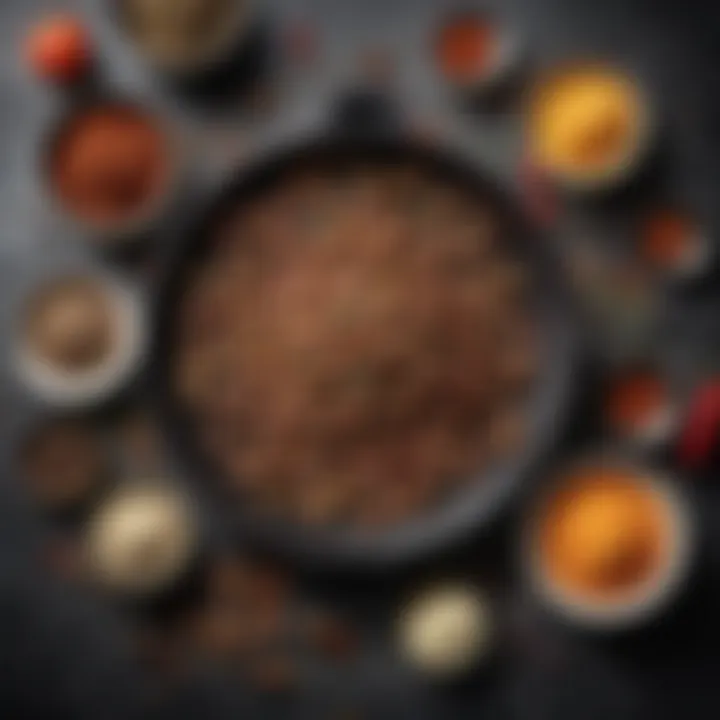Crafting the Ideal Steak Fries Seasoning Recipe


Intro
Creating the perfect steak fries seasoning is not just about sprinkling some salt and pepper here and there; it’s a meticulous dance of flavors that can elevate your dish from ordinary to extraordinary. Steak fries, those delightful thick-cut potatoes that boast a crispy outside and fluffy inside, deserve a seasoning that matches their robust character.
Imagine sinking your teeth into a piping hot steak fry, the right balance of crunch giving way to a soft, warm center. Now, picture that fry perfectly coated with a blend of spices that highlights its natural flavor while adding a new dimension to every bite. In this guide, we’ll walk you through each step of crafting a seasoning that captures the essence of what makes steak fries so special.
This comprehensive exploration will touch on various flavor profiles, ingredient combinations, and preparation methods. We aim to equip you with the knowledge needed to not just season your steak fries, but to create a signature blend that reflects your culinary vision.
Understanding Steak Fries
In the world of culinary delights, steak fries stand tall as a staple that beckons to be savored. Understanding steak fries is not just about recognizing them as batons of fried potatoes; it's about appreciating the history, texture, and cooking methods that elevate these side dishes into the realm of gastronomic pleasure. Every aspect intertwines to create that crispy exterior and fluffy interior that steak fries are known for, making it essential for any food lover to grasp the various characteristics and origins of this popular dish.
Origin and Characteristics
Steak fries, oftentimes mistaken for regular fries, boast a unique identity that stems from their thicker cut. The origins of steak fries are murky, but they likely trace back to the hearty taverns of North America or even Europe, where robust fare was necessary to complement various meats. These fries are typically cut to a width of about half an inch, allowing them to retain substantial potato flavor as they fry up wonderfully. This thickness provides a satisfying crunch, along with a soft, pillowy inside.
It’s fascinating how the concept of steak fries has been embraced differently across regions, with some places opting to serve them sprinkled with paprika or other spices, while others lean on a simple dash of sea salt. Each bite brings forth that distinct potato essence, making it a perfect companion for grilled steaks and burgers alike.
Steak fries have a satisfying heft to them, a quality that makes them stand out on a plate. Unlike thinner fries, they assert themselves rather than play second fiddle to the main dish, allowing them to shine in their own right. Here lies a benefit: their geometric form provides ample surface area, making them perfect canvases for a variety of seasonings, turning even the simplest meal into something extraordinary.
Cooking Methods for Steak Fries
Now, when talking about the methods for cooking steak fries, it's important to note that the path to crispiness can vary widely. While deep frying often comes to mind, baking is a brilliant method for those inclined toward a healthier option.
- Deep Frying: This method crisps the outside while keeping that inside fluffy and delicious. Using a good quality oil like peanut or canola ensures that they fry evenly.
- Baking: This method, while less traditional, can yield surprisingly tasty results. Tossing the fries with some oil and seasoning before spreading them out on a baking sheet allows for a fantastic crispness without submerging them in oil.
- Air Frying: A newer method for many kitchens. This technique uses circulating hot air, giving that quintessential crunchy texture while using only a fraction of the oil.
Regardless of the method chosen, the key to achieving the ultimate steak fry is in the preparation. Preheating the oil in the case of frying, ensuring they’re patted dry, and not overcrowding the pan all contribute to that perfect crunch.
Steak fries can carry a celebrated position on your dining table, inviting diners to enjoy them plain or seasoned creatively. As one navigates through the steps of crafting the perfect seasoning blend, the importance of understanding steak fries truly comes into play. Cooking them the right way, paired with a delightful seasoning, transforms the ordinary into the extraordinary.
"A well-seasoned steak fry can steal the show on even the fanciest dinner plate."
The Art of Seasoning
Seasoning is not just an afterthought; it’s a fundamental aspect of bringing out the best in food, especially in something as hearty as steak fries. In this part, we explore the nuances that make seasoning both an art and a science. Understanding the purpose and the delicate balance of flavors can enhance your culinary experience, turning simple ingredients into an extraordinary dish.
Purpose of Seasoning Fries
When it comes to cooking steak fries, seasoning serves several critical purposes. First and foremost, it adds flavor. Without proper seasoning, fries can taste bland and uninspired, much like a canvas without paint. The right mix can elevate the natural potato flavor while complementing the crispy texture that steak fries are known for.
Moreover, seasoning can create a specific mood or experience. For instance, a blend featuring smoked paprika and garlic powder can evoke a rustic, comfort-food vibe, while a sprinkle of cayenne pepper and lime zest might take your taste buds on a trip to the beach. In essence, seasoning fries gives each bite a story.
Another important aspect is the psychological effect. The aroma of perfectly seasoned fries can draw people in, making them eager to taste. The great thing about fries is they serve as a blank slate, inviting varying flavor profiles.
Balancing Flavors
Getting the right balance in flavors is where the artistry truly shines. The goal here is to create a harmonious blend that celebrates each ingredient rather than letting one overpower the others. Too much salt can mask the subtle sweetness of the potato; too much spice could dominate and overshadow the fries’ natural essence.
To achieve balance, consider the five basic tastes: salty, sweet, sour, bitter, and umami. Each plays a role in how we perceive flavor. For steak fries, a sprinkle of salt provides that essential savory note, while a touch of sugar can cut through any excess bitterness from overcooked oil. An acidic ingredient like vinegar or lemon zest can brighten the flavors, making the fries feel lighter and more refreshing.
Here are some tips for balancing flavors effectively:
- Start Small: When experimenting with spices, begin with a smaller amount. You can always add more, but it’s difficult to tone down an overpowering flavor.
- Layering: Consider layering your spices. For example, using garlic powder and fresh garlic can create a depth of flavor that feels more complex.
- Taste as You Go: This might sound basic, but tasting throughout the cooking process will help you gauge whether you’re headed in the right direction.
A well-seasoned steak fry isn’t just about a single flavor; it’s about creating a well-orchestrated balance that leaves a lasting impression. With the right techniques and a little creativity, you can make your steak fries not only a side dish but a culinary highlight.
"Seasoning is not an accidental touch; it is a careful orchestration of flavors designed to create a culinary masterpiece."
By focusing on these elements, those golden steak fries can remain the star of the show, elevating any meal they accompany.
Key Ingredients for Steak Fries Seasoning


Crafting the perfect steak fries seasoning hinges on the right ingredients. Each element plays a significant role in achieving that tantalizing flavor that makes your fries stand out. Not only does seasoning enhance the taste, but it also elevates the overall dining experience. Understanding the key components is essential for any food enthusiast looking to master this art.
Essential Spices and Herbs
When curating your seasoning mix, consider the depth that spices and herbs bring to the table. Paprika, for instance, adds a smoky depth, while garlic powder imparts a subtle yet recognizable punch that complements the earthiness of potato. Black pepper provides a sharp bite, balancing sweeter components in your blend.
- Thyme: This herb is a classic companion for potato dishes, providing a hint of verdancy.
- Oregano: Infuses a warm, slightly bitter note that works beautifully with the fried texture.
One must remember to balance bold flavors like cayenne pepper or cumin with milder spices. A dash of dried rosemary can also give your fries that aromatic lift, enticing even the finickiest eaters. The proportions matter much; too much of one spice might overshadow the others, making the dish unpalatable.
Salt Variants in Seasoning
Salt is more than a flavor enhancer; it plays the role of a flavor amplifier. Different types of salt can lend unique characters to your seasoning.
- Kosher salt: Its large crystals dissolve slowly, making it ideal for seasoning foods just before frying.
- Sea salt: Provides a briny kick and adds texture, especially if used in a finishing sprinkle.
- Smoked salt: For those looking to infuse a hint of smokiness, this variant is unbeatable.
Choosing the right salt is crucial. Mismatched salt types can lead to an excessively salty fry or, conversely, a bland one. Some may prefer using flavored salts infused with herbs or citrus, presenting an additional flavor layer without introducing complexity. Just a pinch, and you’ll see how salt can transform your seasoning!
Acidity and Sweetness Balance
Balancing acidity and sweetness is like walking a tightrope, but getting it right can take your steak fries to the next level.** Vinegar** — whether balsamic or apple cider — adds a sharp contrast that cuts through the richness of the fry, while a touch of sugar or brown sugar can round off harsher flavors.
- Lemon zest: Freshens the palate with a burst of acidity, creating a lively counterpoint to the savory elements.
- Honey: A drizzle can be an unexpected yet delightful addition, bringing a mellow sweetness that complements your mix.
The secret lies in experimentation. Each ingredient has its personality, and when combined thoughtfully, they create a complex flavor profile that sends your taste buds on a delightful journey.
"Good seasoning isn't just about taste; it’s about crafting an experience that tantalizes the senses and lingers in memory."
Understanding and exploring these key ingredients will lead to an enriching culinary endeavor.
Crafting Your Own Steak Fries Seasoning Recipe
Getting down to making your own steak fries seasoning is not just about throwing some spices together. It’s about creating an experience, a blend that reflects your personal taste and elevates the humble steak fry into something spectacular. This part of the article is not just informative; it’s an invitation to embark on a culinary journey tailored to your palate. The journey starts with understanding the fundamental elements of seasoning, which include selection of spices, the balance of flavors, and considering your personal preferences.
Steps to Create a Homemade Blend
Creating a homemade steak fries seasoning is like composing a piece of music; every ingredient plays a unique role. Here’s a simple guide that can get your creative juices flowing:
- Start with a Base: Begin with a base of salt. This can be regular table salt, sea salt, or even garlic salt if you're looking for an extra kick. Salt enhances flavors and acts as a canvas for the other spices.
- Select Your Spices: This is where the magic happens. Common choices include:
- Add Some Sweetness: A hint of sweetness balances the savory notes. Brown sugar or even a sprinkle of cinnamon can do wonders. Experiment to find what tickles your taste buds.
- Mix It Up: Combine all your chosen ingredients in a bowl. You can use a whisk to ensure everything blends well. The key is to taste along the way. Remember, it's your personal blend, so adjust as you go!
- Store It Right: Once mixed, keep your seasoning in an airtight container. A cool, dark place is ideal. This will protect those flavors from fading too soon.
- Paprika for smokiness and color
- Black pepper for heat
- Onion powder for depth of flavor
- Any dried herbs you fancy, like oregano or rosemary.
Adjusting Seasoning to Personal Preferences
This is where crafting your steak fries seasoning becomes truly personal. One person's perfect blend can be another's too salty or too spicy. Here are a few tips on how to adjust your seasoning to match your taste:
- Taste Testing: Always taste your blend before applying it. A good starting point is one tablespoon per pound of fries, but depending on your ingredient choices, the strength may vary.
- Experiment with Ratios: If you find your seasoning isn’t quite right, try adjusting the ratios. Too much garlic? Tone it down. Not spicy enough? Add more pepper.
- Consider Texture: Some people prefer a finer texture while others might enjoy a more rustic feel. Think about how you want the seasoning to adhere to your fries. Grinding some of your spices can lead to a more uniform mix.
"Cooking is not just about the ingredients, but about the balance and harmony of flavors that make a dish memorable."
- Get Creative: Don’t shy away from unique ingredients. Maybe throw in a touch of smoked salt or a bit of lemon zest for that zing. The sky is the limit!
Creating your own steak fries seasoning is an art form and a science. It’s about engaging with flavors and textures while giving homage to that crispy, golden potato. Take your time, savor the process, and allow your taste buds to guide you toward your personal seasoning masterpiece.
Combining Steak Fries with Complementary Flavors
When it comes to enjoying steak fries, seasoning alone might not do the trick. One of the often-overlooked aspects of elevating this dish is how it interacts with its companions on the plate. The concept here is simple; steak fries, while delicious on their own, can be made spectacular when paired with the right flavors. So, let’s delve into how the right combinations can turn a good meal into a memorable one.
Best Dipping Sauces
Dipping sauces are like the cherry on top for steak fries; they impart moisture and flavor, enhancing your eating experience. To start, a classic ketchup seems to be everyone's favorite go-to. But, let’s think outside the box for a moment. Here’s a short list of alternative sauces that can breathe new life into your fries:


- Garlic Aioli: Creamy and rich, it brings a subtle garlic punch that complements the crispy exterior of the fries.
- Chipotle Mayo: For those who like a kick, this smoky condiment packs just the right amount of heat.
- Honey Mustard: The sweet and tangy profile offers a playful contrast to the savory seasoning on your fries.
- Malt Vinegar: A classic in British fish and chips, its acidity cuts through the richness of fries.
Experimenting with these sauces can turn your steak fries into a full-fledged experience. As you dip and savor, you’ll feel the flavors dance together, creating a symphony of tastes.
Pairing with Different Main Dishes
Integrating steak fries into your meal isn’t just about the fries themselves; it's equally about what you’re serving them with. They can stand up to hearty mains, making them an ideal side for various options:
- Grilled Steak: A match made in culinary heaven, the seasoning on the fries and the charred flavors of the steak can create a harmonious balance.
- Barbecue Ribs: Post-sauced ribs splash flavors everywhere—complement the mess with crispy fries that welcome every drippy bite.
- Roasted Chicken: The juicy tenderness of chicken pairs beautifully with those golden crispy fries, lending a comforting element to the dish.
- Veggie Burgers: Even a vegetarian option can elevate your steak fry game by adding diverse textures and flavors, especially when combined with fresh toppings.
In summary, the right dipping sauces and main dish pairings can transform that meal from an ordinary experience to a mouth-watering feast. \nBy considering complementary flavors, not only do you enhance the steak fries themselves, but you also elevate your entire dining experience, making every bite count.
Exploring Variations of Steak Fries Seasoning
Exploring the myriad of ways to season steak fries is not just a culinary indulgence; it’s an opportunity to personalize a dish that is often seen as straightforward. Every region possesses its own unique flavor influences, often shaped by cultural backgrounds and local ingredient availability. Understanding and experimenting with these variations can elevate your steak fries from simple pale fries into a flavor-packed experience that is sure to impress any palate.
Regional Seasoning Preferences
Different regions have a fistful of flavors that define their culinary identity. For example, in the southern United States, you might find steak fries seasoned with a mix of cajun spices, giving them a kick that’ll make your taste buds dance. These blends often feature paprika, garlic powder, and cayenne pepper for that little bit of heat.
On the flip side, a more holistic approach comes from Mediterranean cuisine, where a sprinkle of oregano, sumac, and a drizzle of olive oil can create a more refreshing taste. This not only enhances the flavor but also complements the earthiness of the potato, providing a nice twist without overwhelming it.
Another area worth mentioning is the influence of Asian spices. Think about using a five-spice blend that incorporates star anise, cloves, and cinnamon for a sweet yet savory punch. This unexpected seasoning allows for a harmony of flavors that transforms the humble steak fry into a side dish with character and charm.
Seasoning variants reflect local tastes and traditions, embracing the culinary diversity found in markets around the world.
Using Unique Spices for Innovative Flavors
Using less common spices can bring a whole new world of flavor to your steak fries. One exciting option is smoked paprika; it brings an alluring depth that can remind one of cooking over an open flame. Its smoky flavor evokes memories of barbecues and brings complexity without excessive heat.
Additionally, introducing herbs like dill can add an unexpected and refreshing flavor. Dill can work remarkably well, especially if you pair it with a squeeze of lemon. This brightens the whole dish and cuts through the richness of fries, making it a delightful accompaniment.
Don’t shy away from experimenting with curry powder, either. It’s a fast track to infusing your fries with flavors like coriander and turmeric. This can lead to fries that not only tempt taste buds but also create a visual feast with a warm golden hue.
The point of verging into these unique territories is endless potential. You never know when you’ll land on a winning combination that transforms your dining experience. The world is ripe for exploration, and your steak fries can serve as the canvas upon which your culinary artistry can shine. By embracing these variations, you’ll not only enhance your cooking skills but also share flavors that can evoke nostalgia or inspire new creations.
Storing Your Steak Fries Seasoning
Proper storage of your steak fries seasoning is crucial to maintain its flavor and aroma. No one wants a blend that has lost its punch or transformed into a dull mix of stale spices. Not only does effective storage prolong the seasoning’s lifespan, but it also helps to keep flavors vibrant and intact, ensuring that your culinary creations shine on the plate.
There are specific elements to consider for maximum preservation. First off, moisture control is vital. Humidity is the enemy of spices, as it can cause clumping and spoilage. Then, there's light, which can degrade certain spices over time, leading to flavor loss. Temperature plays its part too; extreme heat can compromise ingredient integrity, giving them a tired taste. Therefore, choosing the right containers and storage techniques can make all the difference in keeping your steak fries seasoning lively.
Best Practices for Preservation
When it comes to storing your seasoning mixes, a few best practices can help ensure nothing goes to waste:
- Airtight Containers: Use glass jars or BPA-free plastic containers with tight-fitting lids. This step prevents air from seeping in and helps maintain flavor.
- Cool, Dark Places: Store your jars in a cupboard away from sunlight and heat sources like stoves.
- Labeling: It sounds simple, but labeling your containers with the date created and ingredients can aid in managing your pantry more effectively. You don’t want to confuse a zesty blend meant for steak fries with something else.
- Avoid Bulk Storage: If you make large batches, keep some aside for immediate use and store the rest in smaller containers. This approach minimizes exposure to air each time you open the main container.
"Good food begins with good seasoning, and good seasoning deserves good care!"
Shelf Life Considerations
Knowing how long your seasoning mix lasts is essential to avoid any unpleasant surprises. Generally speaking, homemade seasoning can be effective for about six months to a year, depending on the ingredients used. However, the flavors start to fade well before reaching that limit.
Here are a few specific points on shelf life to consider:
- Whole Spices vs. Ground Spices: Whole spices typically last longer than their ground counterparts. If you've got mustard seeds or whole peppercorns, expect them to retain their punch for a longer period compared to already-ground spices.
- Strong Aromatics: Ingredients like garlic powder or onion powder can lose their vigor faster, so keep an eye on them.
- Visual Checks: Regularly check your spices for signs of fading color or loss of aroma. If it doesn’t smell like it used to, it’s time to part ways.
Now that you’re armed with the knowledge of storage and shelf life, your steak fries seasoning can remain fresh and flavorsome for future culinary adventures. The right practices ensure that it's always ready to add that oomph to your meals.
Health Considerations in Seasoning


When creating the perfect steak fries seasoning, it is essential to think beyond flavor; health considerations play a significant role too. As culinary creators, we are not just alchemists of taste, but also stewards of health. Understanding how different ingredients affect our well-being is crucial in this journey. Good seasoning enhances flavor, but when done right, it can also contribute positively to our diet.
A focus on health leads to smarter choices about what goes into our seasoning blend. This can help mitigate some of the negative impacts many seasoning ingredients might have when overused or improperly selected. For instance, opting for low-sodium salt variants or spice blends with less sugar can significantly influence not just the taste, but also the health quotient of our meals.
Nutritional Aspects of Common Ingredients
Common ingredients in steak fries seasoning, such as garlic powder, paprika, and various herbs, bring more than just flavor to the table. Each one carries its own nutritional benefits:
- Garlic Powder: Known for its health perks, garlic helps in boosting the immune system and may lower blood pressure. It's packed with antioxidants.
- Paprika: This vibrant spice is rich in vitamins A and E, which are essential for maintaining good vision and skin health.
- Black Pepper: Often overlooked, black pepper has been praised for its anti-inflammatory properties and may aid in digestion.
- Onion Powder: This ingredient is linked with improved heart health and regulation of blood sugar levels.
Keeping an eye on these benefits helps ensure that seasoning creates a delicious and health-conscious eating experience.
Adaptations for Dietary Needs
In an inclusive culinary approach, it is paramount to adapt seasoning blends to meet diverse dietary needs. Today, individuals follow various dietary patterns—whether vegan, gluten-free, or low-carb. Here are some considerations to keep in mind while crafting your seasoning:
- Vegan Flavor Enhancers: For those who avoid animal products, consider incorporating smoked paprika or nutritional yeast. These give savory undertones without compromising dietary restrictions.
- Gluten-Free Options: Always check that your spice blends are labeled gluten-free. Many commercially available blends may contain seasonings that use gluten as a thickening agent. Opt for individual spices instead.
"Understanding dietary requirements can enrich your culinary practice and broaden your audience."
- Low-Sodium Alternatives: Replace typical salt with potassium salt or herbal blends to lower sodium intake while still delivering flavor. Creating your seasoning ensures you can control sodium content.
- Sugar Substitutes: For those monitoring their sugar intake, consider using spices like cinnamon or herbs like thyme to add sweetness without actual sugar.
Ultimately, being aware of nutritional aspects and dietary needs not only enriches your seasoning skills but also makes for a more thoughtful cooking experience. By tailoring your seasoning blends to accommodate various health requirements, you can elevate enjoyment and satisfaction with every bite.
The Role of Fresh vs. Dried Ingredients
The blend of fresh and dried ingredients plays a pivotal role in crafting steak fries seasoning. Each option brings its own essence, flavor, and character to the dish. Understanding the differences between these two categories can lead to enhanced taste experiences and, ultimately, the mastering of a signature fry blend. When deciding between fresh and dried, consider not just the flavor but also the context in which they'll be used.
Advantages of Fresh Ingredients
Fresh ingredients infuse a vibrant flavor into steak fries seasoning that dry alternatives often can't fully replicate. This exuberance comes from the essential oils and juices present in fresh herbs and spices, contributing to a zesty kick that can elevate even the simplest preparations.
- Intensity of Flavor: Fresh herbs like parsley, rosemary, or cilantro can often deliver a more pronounced taste. For instance, when chopping fresh garlic, it releases oils that create a potent aroma absent in dried forms.
- Nutritional Benefits: Fresh vegetables, especially herbs, are typically richer in vitamins and antioxidants. Incorporating fresh basil or thyme not only brings out flavors but enhances the health aspects of your seasoning mix.
- Visual Appeal: Fresh ingredients tend to be more visually striking. A sprinkle of finely chopped green herbs can turn a simple dish into an aesthetically pleasing feast. The difference can be as stark as using a vibrant green parsley for color compared to a dusty dried version.
"Fresh ingredients can transform a mundane dish into a sensory experience!"
Ultimately, while they may require more storage and preparation time, many chefs and cooking enthusiasts argue that the benefits of fresh ingredients far outweigh the inconveniences.
Utilizing Dried Alternatives Effectively
On the flip side, dried ingredients should not be discounted. They offer convenience and can still produce delightful results when used strategically. They have their own set of advantages and can fit beautifully in different contexts.
- Long Shelf Life: Dried spices stay good for a significantly longer period compared to fresh. This longevity means they can be on hand for spontaneous culinary adventures without any worry about spoilage.
- Concentrated Flavor: In some cases, dried spices like oregano or thyme have more concentrated flavors than their fresh counterparts. When making steak fries seasoning, a pinch of dried oregano can pack a flavor punch that rivals fresh versions.
- Ease of Use: Dried spices often require no preparation. This simplicity can make a world of difference when time is of the essence in meal prep. A dash of smoked paprika can be added to your mix, quickly developing a rich depth of flavor without needing to chop anything.
Participatory Cooking: Sharing and Collaborating
Engaging in participatory cooking, particularly when it comes to creating delicious steak fries seasoning, opens the door to a host of beneficial experiences. This kind of cooking isn't just about following a recipe to the letter; it’s about sharing knowledge, experimenting together, and enjoying the culinary journey as a collective. When friends or family gather in the kitchen, the joy amplifies, and every exchange of ideas only enriches the dish being prepared.
Cooking together fosters a spirit of teamwork and communication, allowing everyone involved to contribute their unique take on flavor profiles. In essence, it transforms a solitary task into a communal event. There's something uniquely gratifying about being elbow deep in flour or spices with loved ones, sharing laughter, or even a little good-natured debate about the right amount of garlic powder to use. Who doesn’t have a sibling who swears by a pinch more of this or that?
Moreover, participating in cooking can also lead to a more profound understanding of flavor balancing. Individuals new to spice blending may learn from seasoned cooks, acquiring tips and tricks that can be life-changing in future culinary adventures. Such practical lessons go beyond mere theory; they embed themselves in the mind through hands-on experience.
"Cooking is an art, but it’s more beautiful when done together."
Encouraging Collaborative Cooking
Getting everyone on board for collaborative cooking can be as simple as hosting a friendly get-together. Resetting the kitchen space for this purpose is essential. A large kitchen table adorned with all necessary ingredients sets the scene for creativity. Invite others to contribute their favorite spices or share family seasoning secrets. This will certainly encourage a sense of ownership and investment in the dish.
It can even be helpful to assign roles—one person chops the potatoes, another measures the spices, and perhaps someone else blends it all together. When there’s an element of teamwork, the stakes feel higher yet more rewarding, and the eventual act of enjoying the fries together brings a sense of accomplishment.
Exchanging Ideas on Flavor Profiles
There's a treasure trove of flavors just waiting to be discovered when participating in a cooking group. Think about the diverse backgrounds and tastes everyone brings to the table. One might favor a more Mediterranean twist with rosemary and thyme, while another could lean towards spicy notes with paprika and cayenne. The exchange of ideas leads to an organic growth of flavors.
Consider keeping an open mind and be willing to try combinations that might initially seem outlandish. For instance, one might suggest a hint of cinnamon to our standard mix, claiming it elevates the natural sweetness of the potatoes. While this idea could seem offbeat, the thrill comes from being willing to taste and adjust based on collective feedback.
In a world where flavors can get stale, collaboration becomes an antidote. It helps breaking the monotony of cooking alone and layers in new techniques and global experiences. Combined creativity results in seasoning that tells a story, integrates cultures, and above all, becomes a symbol of shared memories around the dining table.







